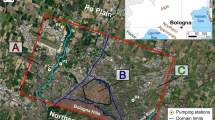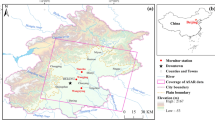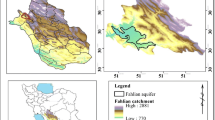Abstract
Human activities have a large impact on land subsidence in great metropolitan areas. In this study, the RADARSAT-2 observation data over a 4-year period (from November 2010 to September 2014) is used to investigate the trends of land subsidence in the eastern Chaoyang District in Beijing, China, and to analyze the impact of human activities on it. The observation results indicate that the temporal and spatial evolutions trend of land subsidence in this area is uneven, with deformation rates ranging from − 116.52 to 7.1 mm/year. There are two large subsidence areas located in the northern part of the study area, and we find that the groundwater exploitation and deformation rates are strongly linearly correlated. The effect of construction on land subsidence has also been investigated. Over time, land subsidence is generally increased in the study area, with an exception at the Longfor Changying Galleria area, which is under construction during the observation period. Based on the time-series analysis of permanent scattered points in the 200 m buffer area, construction activities are observed to cause both land subsidence and upheaval deformation of the surrounding soil. During the construction period, the displacement of the surrounding soil is disturbed. After completion, the initial displacement of surrounding soil is tended to involve the uplift of the surrounding soil, followed by a gradual subsidence with time.








Similar content being viewed by others
References
Amelung, F., Galloway, D. L., Bell, J. W., Zebker, H. A., & Laczniak, R. J. (1999). Sensing the ups and downs of Las Vegas: InSAR reveals structural control of land subsidence and aquifer-system deformation. Geology, 27(6), 483–486.
Chen, B., Gong, H., Li, X., Lei, K., Gao, M., Zhou, C., et al. (2015a). Spatial–temporal evolution patterns of land subsidence with different situation of space utilization. Natural Hazards, 77(3), 1765–1783.
Chen, B., Gong, H., Li, X., Lei, K., Ke, Y., Duan, G., et al. (2015b). Spatial correlation between land subsidence and urbanization in Beijing, China. Natural Hazards, 75(3), 2637–2652.
Chen, B., Gong, H., Li, X., Lei, K., Zhang, Y., Li, J., et al. (2011). Spatial–temporal characteristics of land subsidence corresponding to dynamic groundwater funnel in Beijing municipality, China. Chinese Geographical Science, 21(6), 753–764.
Costantini, M. (1998). A novel phase unwrapping method based on network programming. IEEE Transactions on Geoscience and Remote Sensing, 36(3), 813–821.
Domenico, P. A., & Mifflin, M. D. (1965). Water from low-permeability sediments and land subsidence. Water Resources Research, 1(4), 563–576.
Ferretti, A., Prati, C., & Rocca, F. (2001). Permanent scatterers in SAR interferometry. IEEE Transactions on Geoscience and Remote Sensing, 39(1), 8–20.
Fu, Y., Jin, W., Chen, X., & Tan, J. (2014). Three-dimensional numerical simulation of land subsidence and upheaval deformation caused by high-rise building load. Jilin Daxue Xuebao, 44(5), 1587–1594.
Huang, J. M., Guo, Y., Rang-Quan, H. U., & Zhou, Z. Y. (2013). Analysis of land subsidence in Jinshazhou area, Guangzhou City. Chinese Journal of Geological Hazard & Control, 24(2), 61–67.
Jia, S., Tian, F., Liu, M., & Yang, Y. (2012). The risk assessment method and standard on the construction land subsidence in Beijing area. Urban Geology, 7(4), 7–11.
Li, G. H., Jing, Z. D., & Xu, Z. L. (2008). A discussion of the correlation between land subsidence and groundwater level variation along the Jinghu high speed railway. Hydrogeology & Engineering Geology, 35(6), 90–92.
Perissin, D., Wang, Z., & Lin, H. (2012). Shanghai subway tunnels and highways monitoring through Cosmo-SkyMed persistent scatterers. ISPRS Journal of Photogrammetry & Remote Sensing, 73(3), 58–67.
Phien-Wej, N., Giao, P. H., & Nutalaya, P. (2006). Land subsidence in Bangkok, Thailand. Engineering Geology, 82(4), 187–201.
Strozzi, T., Teatini, P., & Tosi, L. (2009). TerraSAR-x reveals the impact of the mobile barrier works on Venice coastland stability. Remote Sensing of Environment, 113(12), 2682–2688.
Tang, Y. Q., Cui, Z. D., Wang, J. X., Lu, C., & Yan, X. X. (2008). Model test study of land subsidence caused by high-rise building group in Shanghai. Bulletin of Engineering Geology and the Environment, 67(2), 173–179.
University, Chang’an. (2009). Thematic study of the monitoring and control of the land subsidence and ground fissure in Fenwei basin. Xi’an: Chang’an University. (in Chinese).
Werner, C., Wegmuller, U., Strozzi, T., & Wiesmann, A. (2003). Interferometric point target analysis for deformation mapping. In Geoscience and remote sensing symposium, 2003. IGARSS ‘03. Proceedings. 2003 IEEE international (Vol. 7, pp. 4362–4364). IEEE.
Yi, Z., Yun, L., Guo, G., Yong, L., Lei, K., & Rong, W. (2016). A study of the characteristics of land subsidence and the main control factors in the alluvial plain: A case study of Beijing plain. Geological Bulletin of China, 35(12), 2100–2110.
Zhu, L., Dai, Z., Gong, H., Gable, C., & Teatini, P. (2016). Statistic inversion of multi-zone transition probability models for aquifer characterization in alluvial fans. Stochastic Environmental Research and Risk Assessment, 30(3), 1005–1016.
Zhu, L., Gong, H., Dai, Z., Guo, G., & Teatini, P. (2017). Modeling 3-d permeability distribution in alluvial fans using facies architecture and geophysical acquisitions. Hydrology and Earth System Sciences, 21(2), 1–33.
Zhu, L., Gong, H., Dai, Z., Xu, T., Su, X., & Li, X. (2015a). An integrated assessment of the impact of precipitation and groundwater on vegetation growth in arid and semiarid areas. Environmental Earth Science, 74, 5009–5021.
Zhu, L., Gong, H. L., Li, X., Wang, R., Chen, B., Dai, Z., et al. (2015b). Land subsidence due to groundwater withdrawal in the northern Beijing plain, China. Engineering Geology, 193, 243–255.
Zhu, L., Gong, H., Xiaojuan, L. I., Yongyong, L. I., Xiaosi, S. U., & Guo, G. (2013). Comprehensive analysis and artificial intelligent simulation of land subsidence of Beijing, China. Chinese Geographical Science, 23(2), 237–248.
Author information
Authors and Affiliations
Corresponding author
About this article
Cite this article
Si, Y., Chen, B., Gong, H. et al. Temporal and Spatial Evolution of Land Subsidence Induced by Groundwater Exploitation and Construction in the Eastern Chaoyang District, Beijing, China. J Indian Soc Remote Sens 46, 1657–1665 (2018). https://doi.org/10.1007/s12524-018-0821-z
Received:
Accepted:
Published:
Issue Date:
DOI: https://doi.org/10.1007/s12524-018-0821-z




